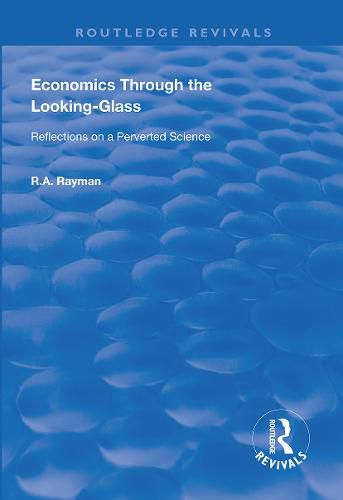Readings Newsletter
Become a Readings Member to make your shopping experience even easier.
Sign in or sign up for free!
You’re not far away from qualifying for FREE standard shipping within Australia
You’ve qualified for FREE standard shipping within Australia
The cart is loading…






Published in 1998. In spite of spectacular improvements in market flexibility, the characteristics of the past twenty years are slow growth and high unemployment. Economics Through the Looking-Glass exposes the theoretical fallacy at the heart of the New Economic Orthodoxy. The fallacy lies in treating the economy as a single-gear machine guaranteed to operate at its full employment potential as long as it benefits from the lubricant of perfectly flexible markets (in a Walrasian Utopia of continuous market-clearing equilibrium). Unemployment is thereby reduced to a structural problem of market imperfection. As a cure for unemployment, market flexibility is presumed to be adequate; as a cure for inflation, monetary restriction is presumed to be safe. The flaw in Orthodox logic is exposed by a demonstration that a monetary economy operates as a ‘multi-gear’ machine. Unless it is in ‘top-gear’, market flexibility (even of Utopian perfection) is not sufficient for full employment. ‘Single-gear’ Economic Orthodoxy is shown to have developed, not as a science, but as a religion beginning with Adam Smith’s revelation of the Law of Competition. A Looking-Glass journey backwards in time from Adam Smith uncovers his suppression of the Law of Circulation and exposes the dangerous delusion of Orthodox economic policy. As a weapon against unemployment, market flexibility is inadequate; as a weapon against inflation, monetary restriction is unsafe. The ‘multi-gear’ alternative heralds the final stage of economic liberalisation: deregulation of the market for money. The rescue of interest rates from political or central bank interference and the control of inflation by a mechanism triggered by market forces would put an end to the Orthodox policy of maintaining unemployment above its natural market rate by misguided monetary intervention.
$9.00 standard shipping within Australia
FREE standard shipping within Australia for orders over $100.00
Express & International shipping calculated at checkout
Published in 1998. In spite of spectacular improvements in market flexibility, the characteristics of the past twenty years are slow growth and high unemployment. Economics Through the Looking-Glass exposes the theoretical fallacy at the heart of the New Economic Orthodoxy. The fallacy lies in treating the economy as a single-gear machine guaranteed to operate at its full employment potential as long as it benefits from the lubricant of perfectly flexible markets (in a Walrasian Utopia of continuous market-clearing equilibrium). Unemployment is thereby reduced to a structural problem of market imperfection. As a cure for unemployment, market flexibility is presumed to be adequate; as a cure for inflation, monetary restriction is presumed to be safe. The flaw in Orthodox logic is exposed by a demonstration that a monetary economy operates as a ‘multi-gear’ machine. Unless it is in ‘top-gear’, market flexibility (even of Utopian perfection) is not sufficient for full employment. ‘Single-gear’ Economic Orthodoxy is shown to have developed, not as a science, but as a religion beginning with Adam Smith’s revelation of the Law of Competition. A Looking-Glass journey backwards in time from Adam Smith uncovers his suppression of the Law of Circulation and exposes the dangerous delusion of Orthodox economic policy. As a weapon against unemployment, market flexibility is inadequate; as a weapon against inflation, monetary restriction is unsafe. The ‘multi-gear’ alternative heralds the final stage of economic liberalisation: deregulation of the market for money. The rescue of interest rates from political or central bank interference and the control of inflation by a mechanism triggered by market forces would put an end to the Orthodox policy of maintaining unemployment above its natural market rate by misguided monetary intervention.